by Karen Lien
We’re back with the second installment of the Edtech in Practice series, featuring interviews with educators from around the country.
This month, we introduce three educators who are leading the charge to teach computer science to students all the way from kindergarten through high school. It's increasingly imperative for students to be conversant in the language of code, and many K-12 schools are experimenting with computer science courses for the first time.
We asked these teachers to share some of their experiences and favorite resources to inspire anyone who may be teaching (or thinking of teaching) computer science.
Thanks for reading!
This month, we introduce three educators who are leading the charge to teach computer science to students all the way from kindergarten through high school. It's increasingly imperative for students to be conversant in the language of code, and many K-12 schools are experimenting with computer science courses for the first time.
We asked these teachers to share some of their experiences and favorite resources to inspire anyone who may be teaching (or thinking of teaching) computer science.
Thanks for reading!
Meet the teachers
Faith Plunkett, Monte Sano Elementary School
At Monte Sano Elementary in Huntsville, Alabama, Faith Plunkett is tasked with teaching every student about technology. Ms. Plunkett focuses on introducing students to the core logic ideas behind computer science, preparing them for programming classes at the middle school and high school levels.
Her students use drag and drop programs like Tynker to build games and apps, rather than writing code letter by letter. The youngest students, who may not yet be readers, use the Kodable iPad game to build algorithms out of arrows and symbols instead of words!
At Monte Sano Elementary in Huntsville, Alabama, Faith Plunkett is tasked with teaching every student about technology. Ms. Plunkett focuses on introducing students to the core logic ideas behind computer science, preparing them for programming classes at the middle school and high school levels.
Her students use drag and drop programs like Tynker to build games and apps, rather than writing code letter by letter. The youngest students, who may not yet be readers, use the Kodable iPad game to build algorithms out of arrows and symbols instead of words!
Jon Armfield, Cardinal Gibbons High School
Jon Armfield teaches engineering, design, and 3D modeling at Cardinal Gibbons High School in Raleigh, North Carolina. Last year, Mr. Armfield launched an introductory programming course using curriculum from CodeHS.
He explained, "I decided to bring coding into the classroom because I know how important it is. But I’m not a programmer, so I lean on CodeHS. It has pacing guides, lesson plans, everything a teacher needs. Students watch video lessons, complete exercises, and go at their own pace."
Jon Armfield teaches engineering, design, and 3D modeling at Cardinal Gibbons High School in Raleigh, North Carolina. Last year, Mr. Armfield launched an introductory programming course using curriculum from CodeHS.
He explained, "I decided to bring coding into the classroom because I know how important it is. But I’m not a programmer, so I lean on CodeHS. It has pacing guides, lesson plans, everything a teacher needs. Students watch video lessons, complete exercises, and go at their own pace."
Tom Simpson, Heathwood Hall Episcopal School
Tom Simpson is a veteran technology teacher at Heathwood Hall Episcopal School in Columbia, South Carolina. Every freshman takes a computer science class with Mr. Simpson, using CodeHS.
Mr. Simpson says, "I took some programming classes in college, but I didn't major in computer science. But I know how to work with computers, I know how to work with students, and now that I’ve tried it, I feel comfortable teaching programming."
Tom Simpson is a veteran technology teacher at Heathwood Hall Episcopal School in Columbia, South Carolina. Every freshman takes a computer science class with Mr. Simpson, using CodeHS.
Mr. Simpson says, "I took some programming classes in college, but I didn't major in computer science. But I know how to work with computers, I know how to work with students, and now that I’ve tried it, I feel comfortable teaching programming."
Words of wisdom
We asked our featured teachers to share some suggestions for anyone looking to introduce a new computer science curriculum. Their advice:
1. Don't be afraid if you're not an expert.
Tell your students that you’re learning alongside them, and lean on resources that provide a structured curriculum, like CodeHS or AmplifyMOOC. For challenging questions, look to your advanced students or your professional network. If you’re using CodeHS, you can also turn to the network of CodeHS tutors for coaching.
Mr. Armfield described the experience of learning alongside his students: “I have students who blew me away months ago, but I don’t necessarily need to be ahead of them. The students have to learn problem solving. It’d be easier for me to just give them the answer, but I don’t know the answer! So we look at online resources and figure out the solutions together.”
Mr. Simpson said, “My students are used to hearing me say, ‘Wow, I didn’t know you could do it that way!’ My kids definitely outsmart me sometimes, but that’s okay. That’s good!”
We asked our featured teachers to share some suggestions for anyone looking to introduce a new computer science curriculum. Their advice:
1. Don't be afraid if you're not an expert.
Tell your students that you’re learning alongside them, and lean on resources that provide a structured curriculum, like CodeHS or AmplifyMOOC. For challenging questions, look to your advanced students or your professional network. If you’re using CodeHS, you can also turn to the network of CodeHS tutors for coaching.
Mr. Armfield described the experience of learning alongside his students: “I have students who blew me away months ago, but I don’t necessarily need to be ahead of them. The students have to learn problem solving. It’d be easier for me to just give them the answer, but I don’t know the answer! So we look at online resources and figure out the solutions together.”
Mr. Simpson said, “My students are used to hearing me say, ‘Wow, I didn’t know you could do it that way!’ My kids definitely outsmart me sometimes, but that’s okay. That’s good!”
2. Bring coding to life with physical interactives and student-relevant applications.
Ms. Plunkett’s students are highly motivated by opportunities to create their own video games and animations. They also love using their knowledge of algorithms to control programmable toys like Bee Bots and Sphero.
Mr. Armfield’s programming students get excited about writing Minecraft plugins and building programs on Raspberry Pi devices. Mr. Simpson’s classes take breaks from coding lessons to design and create with the classroom’s 3D printer or to program their Finch robots. (Last year they programmed the robots to do a dance routine!)
Ms. Plunkett’s students are highly motivated by opportunities to create their own video games and animations. They also love using their knowledge of algorithms to control programmable toys like Bee Bots and Sphero.
Mr. Armfield’s programming students get excited about writing Minecraft plugins and building programs on Raspberry Pi devices. Mr. Simpson’s classes take breaks from coding lessons to design and create with the classroom’s 3D printer or to program their Finch robots. (Last year they programmed the robots to do a dance routine!)
3. Find the right level for your students
Kindergarteners in Ms. Plunkett’s classroom play games like Kodable and CargoBot that introduce the logic behind algorithms. Older primary students use drag-and-drop blocks of code to build programs in Tynker or Code.org.
At the high school level, students are ready to learn proper programming protocols. Mr. Armfield explains, “I want high school kids to be able to look at code and know what’s going on. They can learn the logical structure from drag-and-drop programming, but syntax, vocabulary, and commenting are really important parts of coding. CodeHS teaches them to use the right syntax and the right protocol.”
Mr. Simpson emphasized that it’s important for first-time programmers to feel successful early on. In CodeHS, lessons start out simple. Students use only four commands to program the actions of a dog named Karel, and everyone succeeds. The lessons quickly ramp up in difficulty, but Mr. Simpson notes, “CodeHS is personalized and broken down into small chunks, so students get to work at their own pace, they get positive feedback, and they get the feeling that they’re always progressing.”
Kindergarteners in Ms. Plunkett’s classroom play games like Kodable and CargoBot that introduce the logic behind algorithms. Older primary students use drag-and-drop blocks of code to build programs in Tynker or Code.org.
At the high school level, students are ready to learn proper programming protocols. Mr. Armfield explains, “I want high school kids to be able to look at code and know what’s going on. They can learn the logical structure from drag-and-drop programming, but syntax, vocabulary, and commenting are really important parts of coding. CodeHS teaches them to use the right syntax and the right protocol.”
Mr. Simpson emphasized that it’s important for first-time programmers to feel successful early on. In CodeHS, lessons start out simple. Students use only four commands to program the actions of a dog named Karel, and everyone succeeds. The lessons quickly ramp up in difficulty, but Mr. Simpson notes, “CodeHS is personalized and broken down into small chunks, so students get to work at their own pace, they get positive feedback, and they get the feeling that they’re always progressing.”
4. Make it fun!
Mr. Simpson says, “If you’re doing CodeHS, you have to get Karel the dog! Ninth graders love the dog theme. Every day we start class with a funny dog video from YouTube. Then we try to relate it to coding concepts, like, ‘While there are still balloons, the dog will pop the balloons.’”
Mr. Simpson says, “If you’re doing CodeHS, you have to get Karel the dog! Ninth graders love the dog theme. Every day we start class with a funny dog video from YouTube. Then we try to relate it to coding concepts, like, ‘While there are still balloons, the dog will pop the balloons.’”
5. Look to local industries to impress upon students, parents, and school leaders the importance of computer science.
In Huntsville, Ms. Plunkett’s district was motivated to introduce technology to all of its students due to demand from local companies looking for more candidates with technical backgrounds to fill their job openings.
At Cardinal Gibbons High, Mr. Armfield brings in guest speakers from nearby Cisco Systems to talk with students about job opportunities available to programmers right out of college. His students also look at job postings from their favorite game companies to see the kinds of skills required to work there.
Mr. Simpson’s class meets with engineers from Zverse, a local 3D printing startup, to learn about their technology. This year Zverse also set up an internship for Heathwood Hall students.
In Huntsville, Ms. Plunkett’s district was motivated to introduce technology to all of its students due to demand from local companies looking for more candidates with technical backgrounds to fill their job openings.
At Cardinal Gibbons High, Mr. Armfield brings in guest speakers from nearby Cisco Systems to talk with students about job opportunities available to programmers right out of college. His students also look at job postings from their favorite game companies to see the kinds of skills required to work there.
Mr. Simpson’s class meets with engineers from Zverse, a local 3D printing startup, to learn about their technology. This year Zverse also set up an internship for Heathwood Hall students.
Looking ahead
What’s next for our featured teachers?
Mr. Armfield is looking to explore integrations between the technology and art departments at Cardinal Gibbons High School, to attract more students to programming.
Mr. Simpson is planning to form a robotics club at Heathwood Hall next year and will offer an AP computer science course using CodeHS.
Ms. Plunkett was recently named a PBS Learning Media Digital Innovator and will be working closely with PBS tech experts, as well as other educational partners, to expand Monte Sano’s technology curriculum for next year.
What’s next for our featured teachers?
Mr. Armfield is looking to explore integrations between the technology and art departments at Cardinal Gibbons High School, to attract more students to programming.
Mr. Simpson is planning to form a robotics club at Heathwood Hall next year and will offer an AP computer science course using CodeHS.
Ms. Plunkett was recently named a PBS Learning Media Digital Innovator and will be working closely with PBS tech experts, as well as other educational partners, to expand Monte Sano’s technology curriculum for next year.
Recommended resources
For high school students
For younger students
For anyone
For high school students
For younger students
For anyone
Connect with our featured teachers on Twitter: @MissFPlunkett, @MrArmfieldCGHS, @tsimpsontwit
Does your school teach computer science? Why or why not?
What tools do you use to introduce students to programming?
Tweet us @imaginek12.
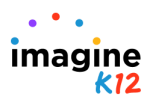
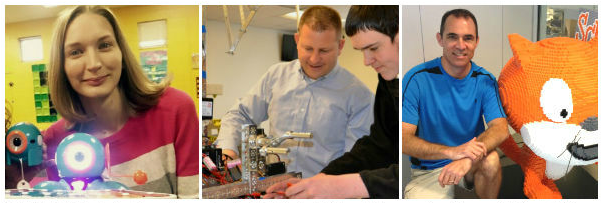
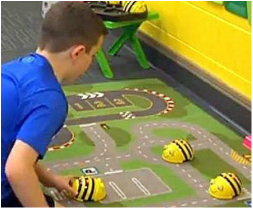
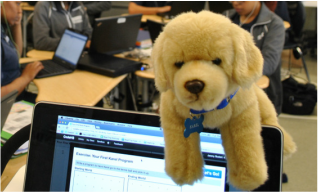
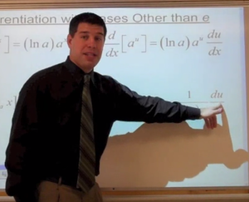

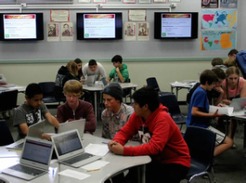
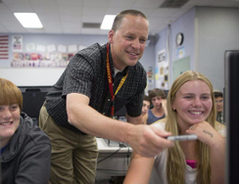
 RSS Feed
RSS Feed